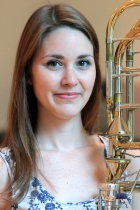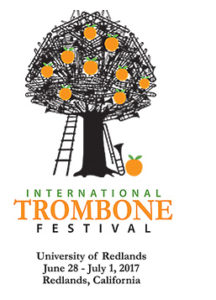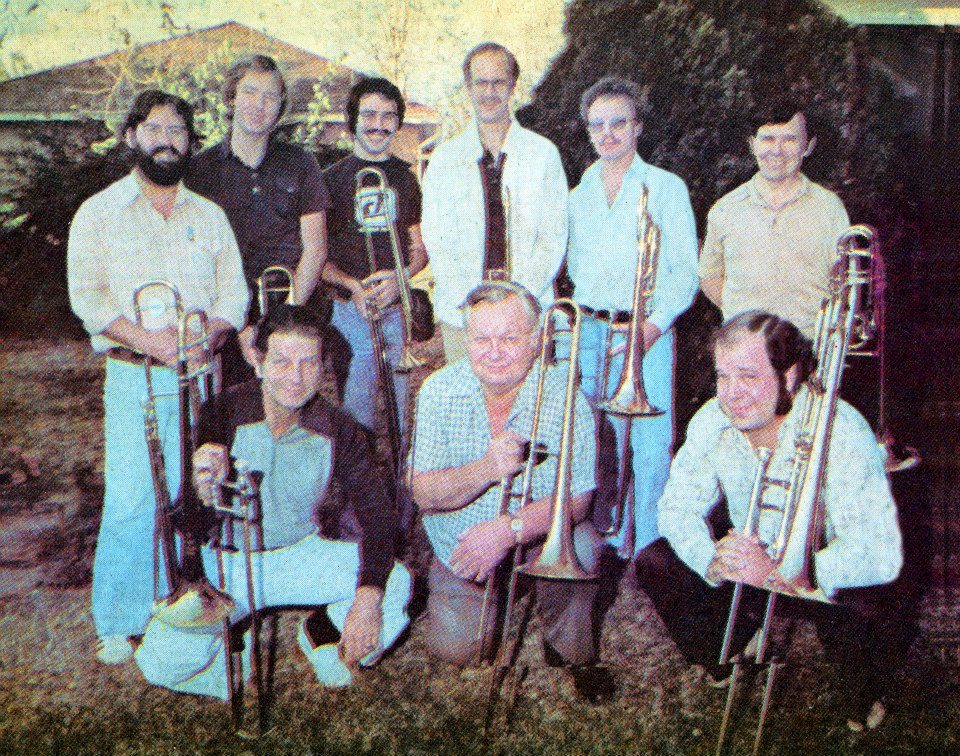Fantastic! Seven Positions in 2017
Matyas Veer
2. What are some of the ways you best like to prepare?
I like to start prepare the pieces very early before the competition.
I always thinking this is is only one project in my life nothing special.
I think for a good result need to be ready with the pieces at least a month before the ‘show”.
In the last weeks need many rehearsals with piano and also make many recordings.
I like to listening back myself, reading the score and analize all of my mistakes. I guess we are the best teachers of ourself.
Also a very good practice in case if you have to play by heart, just listening a recording and play the piece without trombone. If you can singing the melody and move your arm perfect, that means you are ready.
3. How do you manage your mental focus and keep your chops fresh during the competition?
The mental focus is the most important during a competition.
I don’t like to change my daily routine because of a concert or competition. The most important always stay relaxed and think positive.
We need to be happy we can show our best to the jury or to the audience. When we are on stage that is our moment why we practiced. Why should we be nerveous?
Otherwise the biggest problem I think keep warm the embachoure.
Therefore during the waiting time I always try to practice a little bit.
Usually I just play some really basic exercises without using my tounge, focus for the breath and the relaxed throat position.
Read the rest of Matyas Veer’s interview….
Isabelle Lavoie
 1) Do you hear different characteristics in French as opposed to English Speaking brass players?
1) Do you hear different characteristics in French as opposed to English Speaking brass players?
Although I have never done any research on the subject, I believe that the differences between the French and English languages do affect articulation, tongue placement and sound in brass playing.
French and English have almost identical alphabets and yet, they sound completely different. French has way more phonetic sounds than what would be expected from the alphabet.The tongue positions are exaggerated and the vowels sound more short and crisp. The vowels can also be oral or nasal (en, un, on, etc), depending on the jaw position and the tongue position in the mouth. French also has sounds that don’t exist in English, such as ‘R’ (throat), and
‘U’ (tongue at the front of the mouth). Many sounds are more rounded in English, which doesn’t occur in French.
 International French and Quebecois French also differ quite a bit. Quebecois French adds an ’S’ sound after the consonants ’T’ and ‘D’. Those sounds ‘T’s and ‘D’s are almost nonexistent in the English language. The tongue position for the vowels is also more extreme, in front of the mouth. The vowels sound darker, longer, as the oral cavity is more open. Quebecois people can also generally speak International French easily, which opens a whole new world of colours and tones. I would assume that the more languages you speak, the more freedom and options you have on a brass instrument.
International French and Quebecois French also differ quite a bit. Quebecois French adds an ’S’ sound after the consonants ’T’ and ‘D’. Those sounds ‘T’s and ‘D’s are almost nonexistent in the English language. The tongue position for the vowels is also more extreme, in front of the mouth. The vowels sound darker, longer, as the oral cavity is more open. Quebecois people can also generally speak International French easily, which opens a whole new world of colours and tones. I would assume that the more languages you speak, the more freedom and options you have on a brass instrument.
I also believe that every note on brass instruments has its own ideal consonant/vowel option for optimal resonance and best sound, but this is a whole other topic!
2) What are your favorite aspects of playing Operatic music? Ballet music?
Opera to me is the ultimate form of Art.
It involves a visual aspect, story telling, acting, vocal and instrumental music-making. When I’m in the pit, I feel like I am part of something much bigger than me and my own little part. I also think of trombone as the most vocal wind instrument which probably explains why I am naturally drawn to the singing voice (especially mezzo soprano & baritone). I always learn something watching and listening to singers: how do they phrase things? How do they breathe? How do they change the colour in their voice to convey different emotions and characters? How do they project the way they do?
Ballet music often has glorious moments for low brass.
What’s not to love?
Read more of Isabelle Lavoie here…
Bob Sanders
What is your secret to a monster low register?Heavy lips and copious, immediate, but SLOW air; nothing kills low notes like fast air. I should clarify what I mean by “slow.†I feel the terms “slow†and “fast†are frequent used imprecisely. Many folks say “fast†air when they mean “high flow rate†air. “Fast†is measured in distance over time – the time it takes one molecule to go from point A to point B – feet per second. “Flow†is measured in volume over time – the number of molecules that move past point C in a unit of time – liters per minute. These are two very different quantities and usually mutually exclusive. So, when I say “slow†airflow I mean “Mississippi River†airflow, not “fire hose†airflow. Some adjectives I use (borrowed from I can’t remember whom) include “hot, humid, germ-laden†air. Hopefully, this pedantry won’t ignite an online pedagogic conflagration.
Who is the best trombonist you have ever heard live? Jazz trombonist?
That’s a tough one; there are way too many. I will say that Bill Booth, during the recital he split with Tommy Johnson at UCLA in 1992, is in the running for the best I ever heard live; check out his CD, Balancing Act. Not being an improviser, I don’t feel I have the “vocabulary†to really comment cogently on jazz trombonists, and again, there are so many; but I have certainly enjoyed working with and listening to Andy Martin and Bob McChesney.

Hoyt’s a long time ago. — with Loren Marsteller, Steve Holtman, Hoyt Bohannon, Alan Kaplan, Tommy Pederson, Rick Culver, John Leys and Morris Repass.
Read more from Bob Sanders here…
Randy Campora
 8. Can you describe the specialties of brass instruction of each of the following in a few words? What did each do best for you?
8. Can you describe the specialties of brass instruction of each of the following in a few words? What did each do best for you?
Eric Carlson: Pure sound, clean non-aggressive articulation, graded dynamics, consummate ensemble skills, superb low range, non-fussy musicality, vocal approach, sense of humor, love for baseball and ice cream, the ultimate second trombonist!
Arnold Jacobs: Eye opening lesson!, teach each person to maximize their own physical/musical potential, enhance confidence, increase consistency and predictability of musical results, freeing the mind to worry about music, how to use less muscle and more elastic air energy, articulation as speech, I see how my body works best, I played Bolero at the end of the lesson and it worked!, expert at going from an idea to a usable physical technique, the master!
Joe Alessi: Gracious (gave me a free lesson in a very busy week for him!), inspiration personified, never rests on his laurels, one of a kind, high standards, desire to serve and to give to others, super-human, expressive, healthily analytical, inquisitive, part of one of the best sections in history (Dodson, Alessi, Vernon in Philadelphia).
William F. Cramer: Model professor, man of faith, great intelligence, moral and ethical, caring, figured everything out in a vacuum out of the lime light, willing to travel the globe during the Cold War to exchange ideas and materials, encouraging, demanding, crusty but loving, true love of music, supported composers, helped birth the ITA, played Bordogni accompaniments on piano in lessons, no nonsense, didn’t fix what wasn’t broken, fearless, blow freely!
9. As a young bass trombonist in the 80’s, how much did Charles Vernon influence you? How do you view his contributions to the instrument?
I first heard Charlie’s playing via two mono cassette recordings that Dr. Cramer loaned me that he had made himself at the ITA workshops in the mid to late 70s. I was just transfixed, utterly stunned at the musical presentation, the sound, range, control, singing vibrato, the whole thing just floored me. It just seemed like he was playing bass trombone like the angels intended!
 I first got to hear him live when FSU went up to the Eastern Trombone Workshop held at Towson State University in Baltimore in 1979 or 1980. He played the Vaughn Williams Concerto and the Bozza Quartet. I can still hear every note of those tapes and those performances, I still know where he breathed and how he phrased.
I first got to hear him live when FSU went up to the Eastern Trombone Workshop held at Towson State University in Baltimore in 1979 or 1980. He played the Vaughn Williams Concerto and the Bozza Quartet. I can still hear every note of those tapes and those performances, I still know where he breathed and how he phrased.
As the years went on, I heard him several times live with the Philadelphia Orchestra, played trombone ensembles with him and my BSO colleagues in his basement, wore out many CDs and LPs of him with Philadelphia and Chicago (and early Baltimore Symphony recordings—check out his Nutcracker on YouTube or iTunes with Comissiona conducting), and had a couple of lessons with him.
Charlie has done so much for our instrument, I hope he realizes this in his moments of wondering self-doubt, if he ever has them, because his contribution and example are so magnificent. He personifies what Jacobs and Kleinhammer taught, and to be able to hear that buoyancy in the sound and approach is priceless.
The Baltimore Symphony, minus myself, has got to have the greatest bass trombone pedigree of modern history: Ted Griffith (went to Montreal), Charlie Vernon, John Engelkes, and Douglas Yeo. I cannot imagine a better set of players to have to attempt to live up to. I have tried to incorporate a little of each of these players in my orchestral approach (a big shout out to John Engelkes, whose playing I adore).
It’s hard to not hear Charlie’s example in one’s mind whenever one is playing a major orchestral piece that he has recorded. That can be a burden–a siren song to maybe tempt one to reach a little past one’s own self in terms of volume or presence–but if kept in perspective it is a huge guiding star. If I could say one thing to Charlie it would be: thank you! And if I could say one thing to Gene Pokorny it would be: you deserve a medal!
Read more from Randy Campora here….
Matt Guilford
3. Who are your influences?
I grew up in a working class family in a blue collar New England town. The masculine influences in my early life were from men who worked with their hands. My grandfather built most of his home by himself and grew enough produce in his garden to feed a family of seven. My father was a diesel mechanic in the Coast Guard, a career firefighter and could fix just about anything. That I became an artist and academic…it is so far removed from their lives, but their heroism and self-sufficiency made a lasting impact.
Jerry Shaw was not my first trombone teacher, but he was probably the most important teacher. My first few years of playing were with Luther “Sonny†Churchill, who gave me the basics of slide positions and technique. My parents bought me a nearly new Conn bass trombone a few years later (age 13), and that is the time that I began my lessons with Jerry Shaw. Jerry had graduated from music school in Lowell, MA, took lessons with John Coffey (Boston Symphony 1941-’52), played in the U.S. Army Band overseas, AND played bass trombone as well, the same model Conn as mine, the 73H.
 A more dedicated trombone teacher I have never met, and while I would like to imagine that Jerry favored me, I am quite sure that he gave equal attention to all of his many students. Let me put it this way: he taught me how to play the trombone in such a correct and thorough fashion that I constantly ask myself when working with my own students, “What would Jerry say now?â€. The details of my lessons with Jerry are many and honestly deserve an entire article of their own.
A more dedicated trombone teacher I have never met, and while I would like to imagine that Jerry favored me, I am quite sure that he gave equal attention to all of his many students. Let me put it this way: he taught me how to play the trombone in such a correct and thorough fashion that I constantly ask myself when working with my own students, “What would Jerry say now?â€. The details of my lessons with Jerry are many and honestly deserve an entire article of their own.
Finally, and this is a “what†rather than a “whoâ€, an early and important influence was my participation in team sports. Around the same time that I blew my first notes on a trombone, I was involved in sports. In no particular order, I was a team member of many a swim, baseball, football and basketball team. When you are able to ascertain what your own personal strengths and weaknesses may be, you gain the knowledge of how you can best help your team. There is a direct correlation to orchestral playing in this regard, and I am convinced that my early connections to team sports have guided me toward being a better team player.
I have coined a term, virtuoso team player, that might be expressed best as a meshing of personal excellence and artistry in a seamless fashion into the greater good of an ensemble. This has nothing whatsoever to do with virtuosity as commonly conceived vis-a-vis solo artists, their technical prowess, pyrotechnics and so on. Imagine that same level of skill directed not outwardly/individually as a soloist must, but inwardly to the team of orchestral colleagues. There is a virtuosity in the milli-seconds of reaction required in every orchestral rehearsal and concert that is very much the equal of the soloists aim, but it creates a different kind of internal energy that fuels the ensemble.
Read more Matt Guilford here…..
c. 2017 David William Brubeck All Rights Reserved



